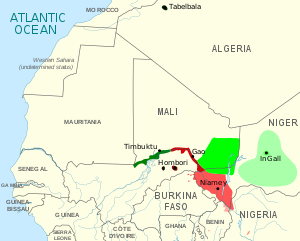Tagdal language
Tagdal (Tuareg name: Tagdalt)[4] is a mixed Northern Songhay language of central Niger. Ethnologue considers it a "mixed Berber–Songhay language",[1][5] while other researchers consider it Northern Songhay.[6] About half of its daily vocabulary is Tuareg, and three quarters overall. There are two dialects: Tagdal proper, spoken by the Igdalen people, pastoralists who inhabit a region to the east along the Niger border to Tahoua in Niger,[5] and Tabarog, spoken by the Iberogan people of the Azawagh valley on the Niger–Mali border.
| Tagdal | |
|---|---|
| Tagdal-Tabarog | |
| Tihishit | |
| Native to | Niger |
| Ethnicity | Igdalan, Iberogan |
Native speakers | 26,900 (2000)[1] |
| Dialects |
|
| Tifinagh | |
| Language codes | |
| ISO 639-3 | tda |
| Glottolog | tagd1238[2] |
 | |
| Agdal | |
|---|---|
| Person | Agdal |
| People | Igdalan |
| Language | Tagdal |
| Abarog | |
|---|---|
| People | Iberogan |
| Language | Tabarog |
Nicolaï (1981) uses the name Tihishit as a cover term. Rueck & Christiansen[7] say that
...the Igdalen and the Iberogan have for many purposes been treated as one group, and their speech forms are closely related. Nicolaï uses "tihishit" as a common designator for these two speech forms...; however, this term is ambiguous. "Tihishit" is a term of Tamajaq origin meaning "the language of the blacks". The Igdalen and Iberogan used it to refer to all Northern Songhay speech forms.[6]
Meanwhile, the Iberogan sometimes refer to their language as Tagdal.
Grammar
Tagdal is an agglutinative language, most likely due to Tuareg influence.
Pronouns
Tagdal gets its pronominal system from Northern Songhay languages.
| Singular | Plural | |
|---|---|---|
| First | ɣɑy | iri |
| Second | nin | ɑnji |
| Third | ɑnga | ingi |
Subject prefixes:
| Singular | Plural | |
|---|---|---|
| First | ɣɑ- | iri- |
| Second | ɘn/ni- | ɑnji- |
| Third | ɑ- | i- |
Tadgal has two different prefixes used for negation. The first is nɘ-, which functions as perfective negation, and is the default choice for negation. It indicates something that might have happened in the past, but didn't, or in the case of stative verbs, something that is not true. The other negation prefix is sɘ-, which acts as a negation in the present or future. Uses of this negation are shown in these examples:[8]
ɣɑnɘkoy: I did not go
ɣɑsɘbkoy: I was not going/I do not (habitually) go
ɣɑnəyɑrdɑ: I disagree
References
- Tagdal at Ethnologue (18th ed., 2015)
- Hammarström, Harald; Forkel, Robert; Haspelmath, Martin, eds. (2017). "Tagdal". Glottolog 3.0. Jena, Germany: Max Planck Institute for the Science of Human History.
- This map is based on classification from Glottolog and data from Ethnologue.
- Ritter, Georg (2009). Wörterbuch zur Sprache und Kultur der Twareg II Deutsch-Twareg. Wiesbaden: Harrassowitz. p. 735.
- Benítez-Torres, Carlos M. (2009). "Inflectional vs. Derivational Morphology in Tagdal: A Mixed Language" (PDF). In Masangu Matondo; Fiona Mc Laughlin; Eric Potsdam (eds.). In Selected Proceedings of the 38th Annual Conference on African Linguistics. Somerville: Cascadilla Proceedings Project. pp. 69–83.
- Michael J Rueck; Niels Christiansen. Northern Songhay languages in Mali and Niger, a sociolinguistic survey. Summer Institute of Linguistics (1999).
- Catherine Taine-Cheikh. Les langues parlées au sud Sahara et au nord Sahel. De l'Atlantique à l'Ennedi (Catalogue de l'exposition « Sahara-Sahel »), Centre Culturel Français d'Abidjan (Ed.) (1989) 155-173
- Benítez-Torres, Carlos M. (2009). "Inflectional vs. Derivational Morphology in Tagdal: A Mixed Language". Cite journal requires
|journal=(help)